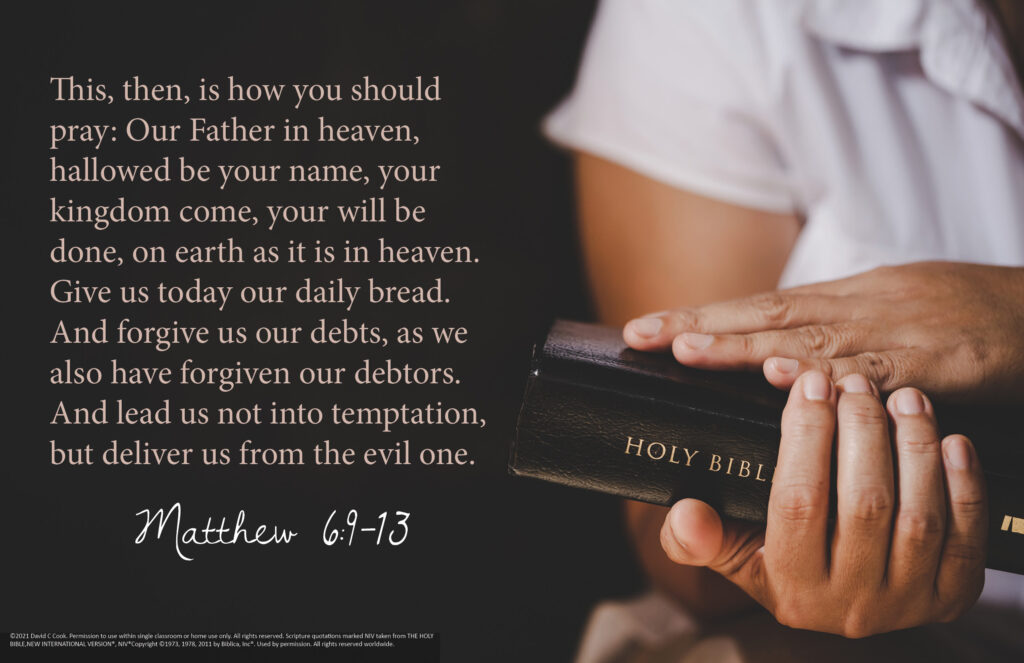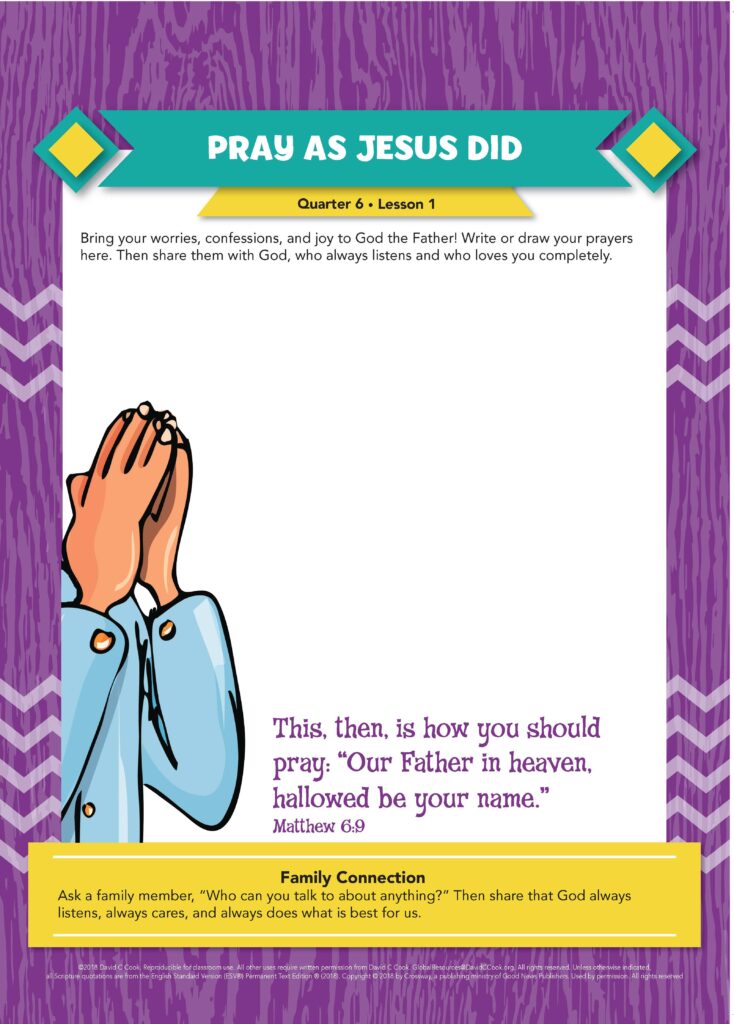During the lesson, the information for you to know is written in regular type, and what we suggest speaking or reading aloud to children is in bold. All resources for this lesson, including the Teacher Guide, Student Page, Family Connection Card, and other resources can be downloaded in a ZIP file by clicking on the following link:
In some lessons you will find "resource articles." These are articles written by experts from around the world to help equip you for your work with children and adolescents. Share them with parents or guardians if you consider it appropriate.
Optional: Before class, set up a prayer response station for the students to use to actively respond in prayer. Create a prayer response station by choosing an option below:
Students will respond by adding papers or rags to represent their prayers.
If possible, leave this station up for the next several weeks. If you are able to keep it up permanently, you may choose to use it in other lessons as well.
End of Option
One day Jesus was praying in a certain place. When he finished, one of his disciples said to him, “Lord, teach us to pray, just as John taught his disciples.”
Luke 11:1
When Jesus’ disciple made this request, he and the rest of the disciples had already spent many months observing Jesus’ prayer habits. They must have noticed how Jesus made prayer a priority, often slipping away to spend time with His Father. No doubt they had observed His close relationship with God and how He shared His heart with the Lord in prayer. Jesus modelled the value and necessity of prayer, and His disciples wanted to know more.
In response, Jesus gave them a model of prayer. This prayer is familiar around the world. It may be familiar to you, but has it helped you to become more like Jesus? Ask God to make the words fresh to you and your students. How is your life changed by the knowledge that God provides for you, forgives you, and protects you? How can you rely on the words of this well-known prayer to help you grow closer to the Lord? Spend some time talking to your heavenly Father as Jesus did, and thank God for all He does for those who love Him. His is the kingdom and the power and the glory forever and ever—and He cares about everything you share with Him.
Encourage the students to ask their family members, “Whom can you talk to about anything?” The students can then share that God always listens, always cares, and always does what is best for us.
Teacher Tip: If possible, email or text the Family Connection Card to the families of your students.
Divide the teens into 2 equal groups. If you have an uneven number of students, you can join the game. Have the teens stand in 2 lines facing each other. The lines should be 5–8 meters apart.
The person standing across from you is your partner. When I say to begin, ask your partner these questions.
Tell the students to begin. Because the lines are far apart, the partners will need to speak loudly to hear each other. After a minute, stop the conversations and ask the following question.
Repeat the exercise, but have the lines stand only about 2 meters apart this time. The students will ask each other the following questions.
After 1–2 minutes, stop the conversations and ask the following question.
Being close helps us to have stronger relationships. In this activity, moving physically closer helped us to communicate better. But closeness is about more than standing near each other. It involves getting to know each other so we understand and trust each other. In the first round of the activity, we learned a little about each other. The answers from the first round helped us to learn more about each other in the second round.
Growing in closeness in our relationship with God happens in a similar way. When we feel closer to Him, it is easier to talk with Him and listen to Him. Today we will learn how to grow closer to God through prayer. Let’s start with some of the things we already know about God.
Optional: If you have a whiteboard or large piece of paper, you can write the teens’ answers to the following questions on the board or paper.
Allow 2–3 teens to answer. Guide students toward the idea of the closeness and trust that a child has with a loving father. Jesus addressed God as “Father” because He loved Him deeply and was close to Him.
Jesus has a close, loving relationship with God and calls Him “Father.” This name shows the closeness of their relationship. God is a Father who protects, provides for, and loves us.
As we learned from the activity, the closer we are to someone, the easier it is to communicate with that person. This is also true of our relationship with God. We cannot know Him or understand what He wants for our lives if we do not spend time with Him in prayer.
Prayer allows us to worship and communicate with God. It allows us to praise Him for being good and loving. It allows us to thank Him for all He does for us every day. It allows us to share our concerns and ask for God’s help. It allows us to confess our wrongs and ask for His forgiveness. Most of all, it deepens our relationship with the One who created us.
Optional: If possible, share the image from The Action Bible.

Jesus knew this. Through prayer, He drew close to His Father. In this relationship with His Father, Jesus could talk openly with the One who knew Him completely. We can talk with God in the same way.
Let’s read how Jesus prayed to see what we can learn from His example.
Have a student read Luke 5:16 aloud from the Bible. If that is not possible, the verse is printed here for you.
But [Jesus] would withdraw to desolate places and pray.
Luke 5:16
It tells us that He prayed alone and often.
Spending time alone with someone allows you to get to know that person more deeply.
Allow students to share their thoughts. Guide them to understand that the more often we are with someone, the deeper our relationship can grow.
Then people brought little children to Jesus for him to place his hands on them and pray for them.
Matthew 19:13
It tells us that Jesus prayed for others. It also tells us that no one is too young or unimportant for God’s love.
Guide the students to understand that praying for others allows us to show His love to them. It also keeps us focused on loving others as we love ourselves.
[Jesus] took Peter, John and James with him and went up onto a mountain to pray.
Luke 9:28
It tells us that Jesus asked others to pray with Him.
Guide the students to understand that praying with others strengthens the relationships between those praying as it helps us to understand others’ feelings and concerns. It gives us an opportunity to know each other’s needs and pray for one another.
Through all these examples, we can learn that we can pray alone, often, and with and for others. Jesus also gave us a model of how to pray. Listen to what He taught to His disciples.
Have a student read Matthew 6:9–13 aloud from the Bible. If you are using the Memory Verse Poster, show it to the students.

This, then, is how you should pray: Our Father in heaven, hallowed be your name, your kingdom come, your will be done, on earth as it is in heaven. Give us today our daily bread. And forgive us our debts, as we also have forgiven our debtors. And lead us not into temptation, but deliver us from the evil one.
Matthew 6:9–13
In the next few lessons, we will learn more about this special prayer. This prayer has 6 requests in it. The first 3 focus on God—who He is and what He does. The second 3 focus on our needs. God is concerned for both, so we should also think about both.
Today we will learn more about the first sentence: “This, then, is how you should pray: “Our Father in heaven, hallowed be your name.”
Ask another student to read Matthew 6:9–13 aloud from the Bible.
Jesus told His disciples to pray only to God, the One True God who is in heaven. He did not teach them to pray to other gods or saints.
This prayer teaches us that we can come to God as our Father. He loves us as a good father loves his children. God loves all of us deeply, and He hears us when we call on Him. If we have accepted His free gift of salvation through Jesus’ sacrifice, then we are His children and part of His family.
Guide the students to understand that “hallowed” means to honour, value, respect, or treasure more highly than others. It means that we recognize God as holy and above all else. God’s name is more important than any other name.
This prayer teaches us that God’s name—who He is—should be honoured more than anything or anyone else. We can talk to Him as we would to a loving Father. But we must also remember to worship and honour Him since He is holy and should be highly respected. Our relationship with God in prayer should be one of awe and love.
Jesus teaches us that we can pray about anything at any time. Our heavenly Father is always listening. He loves us. He wants to have a relationship with us. We can pray to God about the things we want and need, just as Jesus did. We can ask God to help us honour Him in our lives.
There is no problem too big or too small for God. There is nothing you can say or do that will make Him love you more or less. Even though God is holy and honoured, there is nothing you should ever be embarrassed, ashamed, or afraid to talk with Him about. You can always trust that He will listen and do what is best for you because He is good and He loves you deeply and completely. This does not mean that you will always get what you want. Just like an earthly father sometimes says no, God may say no to your request if it is not what will be good for you. That is what a loving Father does—always providing what is needed and best!
Today we learned that prayer is talking with and listening to God, our heavenly Father. He is worthy of honour and respect.
God invites you to come to Him in prayer. You can come to Him with confidence, knowing that He loves you as a caring Father. The more you talk with God, the better you will know Him and the easier it will become to share your concerns, your fears, your praise, and your love.
Think about how you feel about going to God as your Father. Think about a way you can honour Him. What is something you can tell God right now? It may be to tell Him how you feel about Him. It may be some way you want to honour Him. It may be a need or question you have.
Optional:
If you are using the prayer response station, show it to the students. If you are using paper, allow the students to write or draw something that represents their prayers. They can lay them on the tree or attach them with string or tape. If you are using rags or strings, tell the students that these are symbols of their prayers, and they should tie them onto the branch. After they have responded, they should wait quietly as others respond.
If you are using the Student Page, the students can write or draw their prayers on their pages and attach them to the response station.

End of Option
God cares for and listens to us. We can bring our worries, our fears, our joys, and our confessions to Him. We can trust that He will listen and will answer in the way that is best for us. We do not need to use a response area as we did today. We can bring our praises and concerns to God anytime and anywhere.
If you are not ready to bring your needs to God, think about whom you can trust with your difficulties. Whether you bring your cares to God or not, He loves you and cares about the things you are struggling with. If you have questions about how God can help with your needs, I am available to talk with you after class.
Close by praying a blessing based on Hebrews 4:16.
Blessing: May you approach with confidence the throne of your Father, who loves you deeply and completely. May you feel His mercy and grace at work in your life.
When everyone has had time to respond, lead the students in singing this quarter’s song, if possible.
Life on Life ©2020 David C Cook. Reproducible for home or classroom use only. All other uses require written permission from David C Cook [email protected]. All rights reserved.